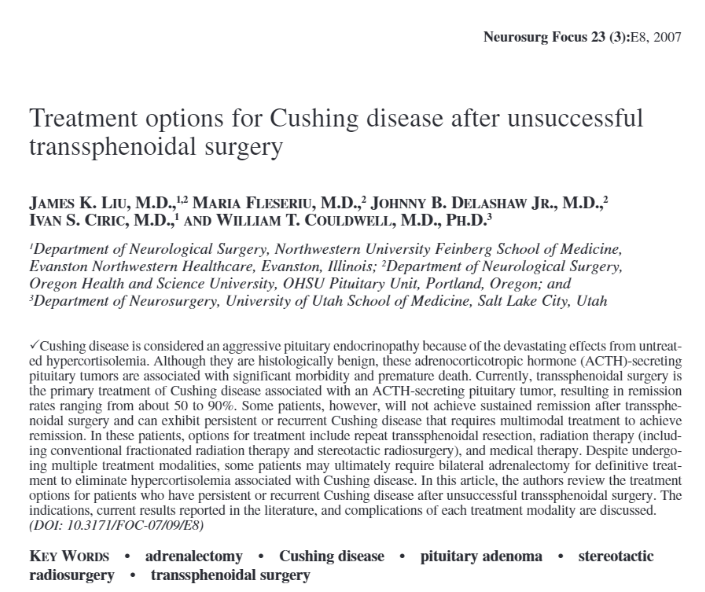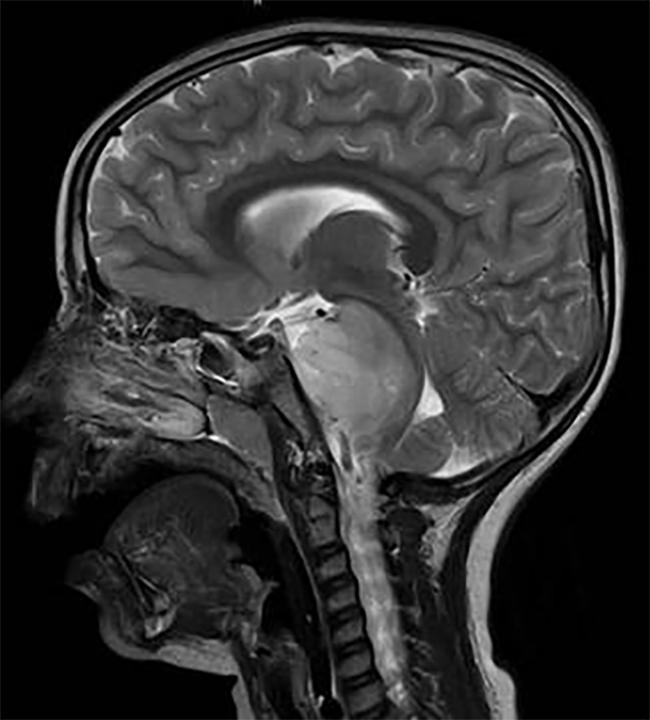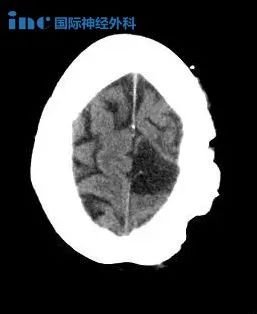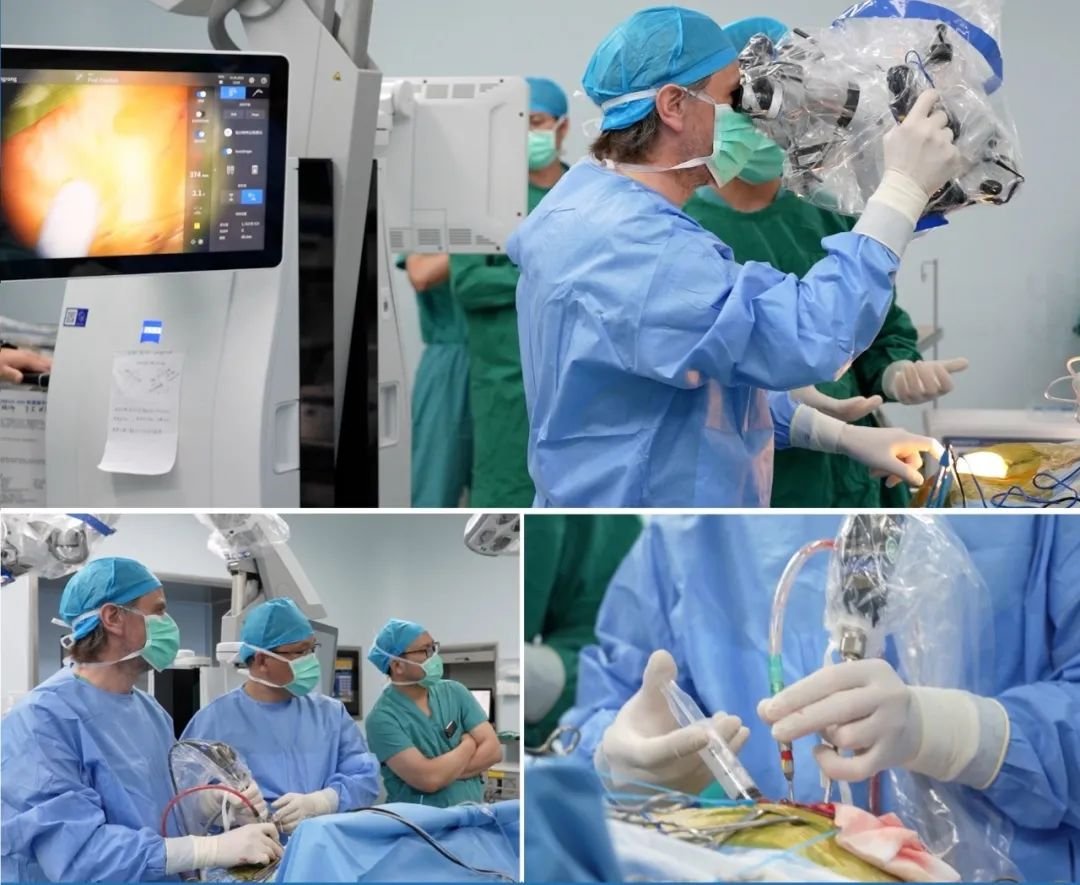库欣病经蝶窦手术失败后的治疗方法(Treatment options for Cushing disease after unsuccessful transsphenoidal surgery)
英文简介:
Cushing disease is considered an aggressive pituitary endocrinopathy because of the devastating effects from untreated hypercortisolemia. Although they are histologically benign, these adrenocorticotropic hormone (ACTH)-secreting pituitary tumors are associated with significant morbidity and premature death. Currently, transsphenoidal surgery is the primary treatment of Cushing disease associated with an ACTH-secreting pituitary tumor, resulting in remission rates ranging from about 50 to 90%. Some patients, however, will not achieve sustained remission after transsphenoidal surgery and can exhibit persistent or recurrent Cushing disease that requires multimodal treatment to achieve remission. In these patients, options for treatment include repeat transsphenoidal resection, radiation therapy (including conventional fractionated radiation therapy and stereotactic radiosurgery), and medical therapy. Despite undergoing multiple treatment modalities, some patients may ultimately require bilateral adrenalectomy for definitive treatment to eliminate hypercortisolemia associated with Cushing disease. In this article, the authors review the treatment options for patients who have persistent or recurrent Cushing disease after unsuccessful transsphenoidal surgery. The indications, current results reported in the literature, and complications of each treatment modality are discussed.
Abbreviations used in this paper: ACTH = adrenocorticotropic hormone; CRH = corticotropin-releasing hormone; GABA = γ-aminobutyric acid; GI = gastrointestinal; MR = magnetic resonance; SRS = stereotactic radiosurgery.
中文简介:
由于未经治疗的高糖皮质激素血症的损害性影响,库欣病被认为是一种侵袭性垂体内分泌病。尽管在组织学上是良性的,这些促肾上腺皮质激素(ACTH)分泌垂体肿瘤与的发病率和过早死亡有关。目前,经蝶窦手术是与垂体ACTH肿瘤相关的库欣病的主要治疗方法,其缓解率约为50 - 90%。然而,有些患者经蝶窦手术后不能达到持续缓解,可能表现出持续性或复发性库欣病,需要多模式治疗才能达到缓解。在这些患者中,治疗方法包括重复蝶窦切除术、放射治疗(包括传统的分步放射治疗和立体定向放射外科治疗)和药物治疗。尽管经历了多种治疗方式,一些患者较终可能需要双侧肾上腺切除术来明确治疗,以消除与库欣病相关的高糖皮质激素血症。在这篇文章中,作者回顾了库欣病在不成功的蝶窦手术后的治疗方法。讨论了各种治疗方法的适应证、目前文献报道的结果和并发症。
本文使用的缩写:ACTH =促肾上腺皮质激素;CRH=促肾上腺皮质激素释放激素;GABA =γ-氨基丁酸;GI=肠胃;MR磁共振;SRS 立体定向放射外科。

库欣病是由功能性垂体前叶ACTH腺瘤引起的,是ACTH依赖性库欣综合征较常见的病因。对于神经外科医生和内分泌学家来说,库欣病的治疗仍然具有挑战性。经蝶入路手术是目前治疗垂体ACTH分泌瘤合并库欣病的优选方法。该手术提供了快速生化缓解的更佳选择,长期效果良好。经验丰富的外科医生经蝶窦切除术后的缓解率大约在70%到90%之间。长期随访需要进行生化检测,以发现肿瘤复发,因为随着随访时间的延长,缓解率下降。虽然许多患者病情完全缓解,但这些肿瘤很难通过手术治愈,有些患者可能表现出持续或反复的ACTH和高糖皮质激素分泌,导致与恶性内分泌病相关的发病率和死亡率增加。不幸的是,文献中关于经蝶窦手术后内分泌学分析的结果各不相同,因为不同的研究对生化治疗有不同的定义。
如果库欣病的生化证据在初次蝶窦手术后仍然存在或复发,外科医生应熟悉可供患者选择的治疗方案,包括重复蝶窦手术、放射治疗、药物治疗和双侧肾上腺切除术。在一些患者中,使用这些治疗组合的多模式方法可能是获得更佳结果的适当策略。为了获得更佳的结果,一个多学科的团队方法应该在一个专门的中心进行协调。在这篇文章中,我们对经蝶窦手术失败后可用的管理方法进行了概述,并根据文献报道的结果,回顾了每种方法的当前结果数据。
该研究主要人员之一是INC国际神经外科医生集团旗下组织国际神经外科顾问团(WANG)成员William T. Couldwell教授。William T. Couldwell教授擅长领域涵盖脑膜瘤、脑胶质瘤、脑动脉瘤、颅底手术、中风、创伤性脑损伤、头部创伤和神经重症护理等方方面面。擅长脑膜瘤等脑部、颅底、神经肿瘤、垂体肿瘤、癫痫和脑血管神经外科等的外科治疗。主要研究包括颅底肿瘤的外科管理;脑胶质瘤、垂体腺瘤与脑膜瘤中的信号转导与凋亡;多种神经外科疾病如动脉瘤和各种脑瘤的遗传性等。
资料来源:https://thejns.org/focus/view/journals/neurosurg-focus/23/3/foc.2007.23.3.10.xml
- 文章标题:库欣病经蝶窦手术失败后的治疗方法
- 更新时间:2019-11-15 17:01:36

 400-029-0925
400-029-0925





